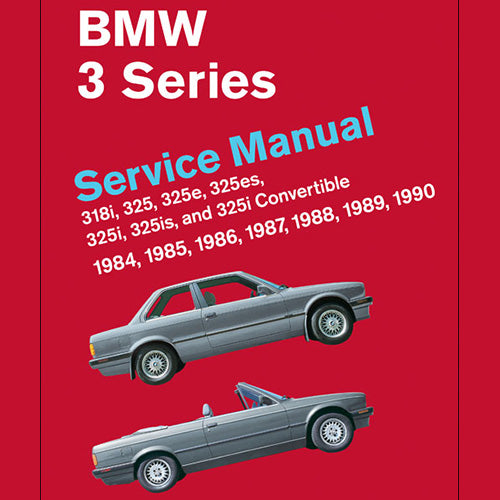Photos courtesy of Bentley Publishing
My wife says the only reason I know how to fix anything is because I'm constantly breaking everything. Since I was a child, I have been breaking things. Sometimes it was an accident, and sometimes I inadvertently destroyed things in an attempt to tinker with or modify them. To “make them better”. So it was only a matter of time before I turned my attention to fixing, and modifying something more complex and expensive: my car.
Almost as soon as I got my license, I set out to make my mark on my first set of wheels. While I was full of youthful brio for car modifications, what I should have worried about was my own technical ability, and I have a sneaking suspicion that the built-in radar detector I installed probably aided more with the battery losing its charge than with me avoiding a speeding ticket, not that I should have worried with less than 100 horsepower at my disposal. Sorry, Dad—I shouldn’t have done it!



Now that I’m older, and wiser, one of the tools that has allowed me considerably more insight into how things are put together has been a service manual. Cars are considerably more complicated than one might think, even vintage models, and one way you can learn about your car is by purchasing a repair guide for your particular model. While you could purchase a factory service manual, companies like Bentley Publishing exist to make our lives more straightforward by producing somewhat simplified repair books geared more toward the hobbyist mechanic.
I own and (to the best of my abilities) care for a (993 in Porsche-speak) 911 Carrera. Anyone who has attempted a complicated repair job can attest to the importance of solid instructions, and while there are plenty of people who possess the skills to be able take apart their own cars without instructions, I’m certainly not one of them, or willing to go in blind.
While my goals are more modest, a service manual has still been essential to tackling some some of the smaller automotive DIY projects with less fear of getting into trouble, and dare I say, perhaps even gaining a modicum of confidence.
Those of you who already have seen Bentley manuals for another model of car will also probably recognize the familiar format. In our featured Porsche 911 Carrera Service “Type 993” Manual there are sections on General Maintenance, Engine, Engine Management, Exhaust and Engine Electrical, Clutch and Transmission, Suspension, Brakes and Steering, Body, Heating and Air-conditioning, and Electrical System. Each section stands on its own, and chapters usually correspond to a specific system on your car.
Clear, easy-to-interpret color photographs accompany straightforward and easy-to-follow instructions. Everything is task-based, from start to finish, and the estimated time and needed tools for every job are mentioned every step of the way so you are never unprepared.


The factory wiring diagrams are well-integrated, with wiring tracks coded with letters to allow for easy tracing of an individual wire from one page to another. Removing and installing trim pieces, changing the oil in the transmission, troubleshooting electrical issues—whatever might plague your car, the remedy or way to do it is in one of the sections for you to discover. It’s almost like you have someone with you showing you what to do every step of the way.
One of the things that I had been thinking about repairing recently was repairing the driver’s door seal. After almost 20 years of people getting in and out, it had developed a deep scuff that seemed determined to become a tear soon. Now, the old me might have taken it to my trusty mechanic, but thanks to the Bentley manual plus some genial advice from the internet forums such as Rennlist, I was more than able to tackle the replacement myself.
The Bentley manual told me how to remove the old rubber, the part number, as well as tell me the method to prepare the area to accept the new one and install it in place fairly easily (and without tearing the new part). Not only was doing it myself very gratifying, I saved some money in the process.
I’ve also successfully DIY’d a few other repairs like the retractable spoiler wall, replaced the fog lights with the “Turbo S” ducts, pulled out the ECU, changed out the steering wheel, shift knob, and gear handle, and probably a dozen other things. Am I going to be rebuilding the engine anytime soon? Probably not. Are there going to be snafus along the way as you figure things out? Of course there are.


For instance, the words in the manual “should remove easily” can be misleading at times. Perhaps the real-world translation should be: “will be corroded into place, beat repeatedly with a hammer”. Likewise, ease could also be apply superhuman strength. But the point is a service manual like this will prepare you to take on any number of smaller DIY projects before perhaps reaching for loftier heights.
By studying service manuals, will you become an ace mechanic overnight? No. Bentley manuals are well-written, and a mechanic doesn’t pop out of the book like a genie to save you from doing something stupid or if you get in trouble. But what it might just do is give you an assured helping hand to tackle some jobs yourself...which could just save you money, give untold satisfaction, and makes you appreciate driving your car just a little bit more.
The more a driver knows about how their car works makes him or her a better driver...and makes their drives, wherever they choose to venture, more pleasurable.
Bentley Publishing has graciously provided Petrolicious readers with a 30% discount for a limited time off the retail list price of select service manuals. Here is the link to the offer page, promo code: PETROFRIEND























































